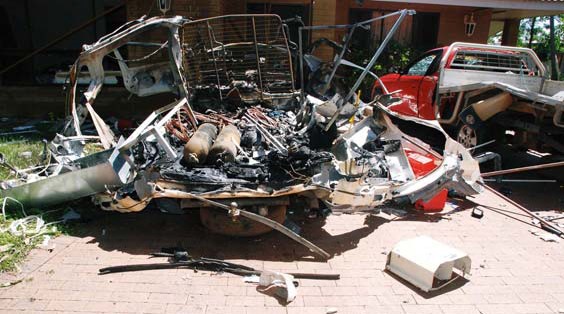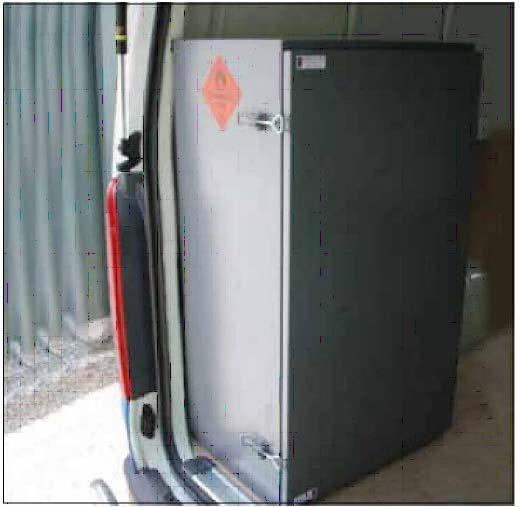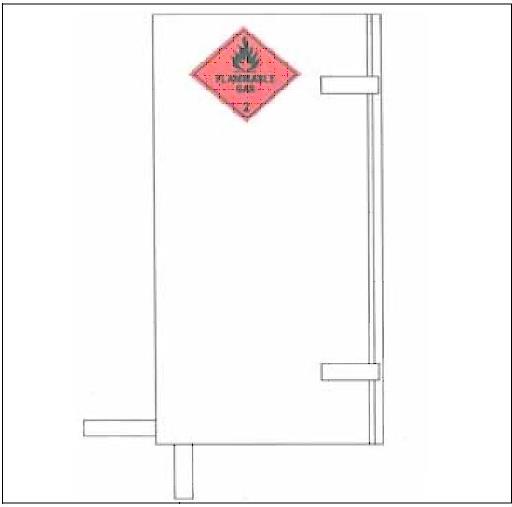Storing gas cylinders in vehicles
The purpose of this Safety Alert is to provide advice about how to manage the risk of explosion from leaking portable flammable gas cylinders inside work vehicles.
Background
A 24-year old tradesman died after his work vehicle exploded in the suburb of Parap in December 2011. Preliminary findings from the NT WorkSafe investigation show the most probable cause of the explosion was gas from leaking portable gas cylinders igniting inside the vehicle.
The fatality occurred four days after a similar incident in Melbourne where a 25-year old tradesman died. There have been other reported cases of explosions and in many cases the ignition source was the vehicle’s electrical system.
Flammable gas cylinders include those containing oxygen, acetylene, liquefied petroleum gas and propane or butane throwaway-style cylinders.
These incidents could have also killed or seriously injured members of the public.

Action required
- Gas cylinders should be stored and transported in vehicles with cargo areas open to the air, and not stored inside closed type vehicles. When storing or transporting fuel gas cylinders, ensure:
- main cylinder valves are tightly closed
- there is no leakage from the main valve area (e.g. using a gas detector or soapy water test)
- cylinders are secured in an upright position to prevent them tipping or falling over
- cylinders cannot be struck by other objects (e.g. loose tools and materials)
- cylinders are always removed from the vehicle before the gas is used
- at least one 10B dry-powder fire extinguisher is fitted in the driver’s cabin.
Open-type vehicles
Open-type vehicles have cargo areas open to the air with unrestricted ventilation. The cargo areas of some open-type vehicles with sides (e.g. utility vehicles) can potentially retain escaped gas.
This is due to escaped gas flowing to and accumulating in low, enclosed and poorly ventilated areas. If you are not sure if your cargo area may allow gas to accumulate, assume it can until a competent person determines otherwise.
The cargo area should be assessed by a competent person for its potential to retain gas, and to identify the likely areas where gas could accumulate. Consider installing vents in these areas.
Closed-type vehicles
Closed-type vehicles are vans, utilities and other vehicles that have cargo areas with restricted natural air movement and ventilation. This includes vehicles where gas cylinders are stored under canopies, inside service bodies or toolboxes, and vehicles where cylinders are covered by tarps or tonneau covers.
If you cannot avoid using a closed-type vehicle, it should be fitted with a separate gas storage cabinet that is vapour-tight from the rest of the vehicle.

The gas cabinet must be secured to the vehicle and be big enough to store all cylinders carried in the vehicle, including empty cylinders. It must be designed to ensure gas from leaking cylinders cannot accumulate inside the cabinet but is vented to the atmosphere outside the vehicle. The cabinet door must be securely sealed whenever cylinders are stored in the cabinet.
The cabinet must have:
- one or more permanent vents or drains positioned at the bottom of the cabinet (either floor or side) with an internal diameter of at least 25mm
- vents located so they cannot be blocked when the cylinders are in the cabinet
- a way of securing cylinders in an upright and stable position (e.g. straps)
- a visible flammable gas label on the outside
- regular inspections and maintenance of door seals and vents.
Gas cabinets must also be installed and maintained in accordance with the manufacturers’ instructions. No more than 50L water capacity in total of gas/acetylene is to be transported in the storage cabinet.
Gas cabinets are available gas suppliers and safety equipment suppliers.

Information and training
Ensure workers are informed and trained in procedures for:
- checking and testing for leaking cylinders
- securing cylinders and sealing gas cabinets
- regularly checking cabinet seals and vents
- dealing with damage to the gas cabinet, gas leaks or explosion.
Disclaimer
This Safety Alert contains safety information following inquires made by NT WorkSafe about an incident or unsafe practice. The information contained in this Alert does not necessarily include the outcome of NT WorkSafe’s action with respect to an incident. NT WorkSafe does not warrant the information in this Alert is complete or up-to-date and does not accept any liability for the information in this report or as to its use.